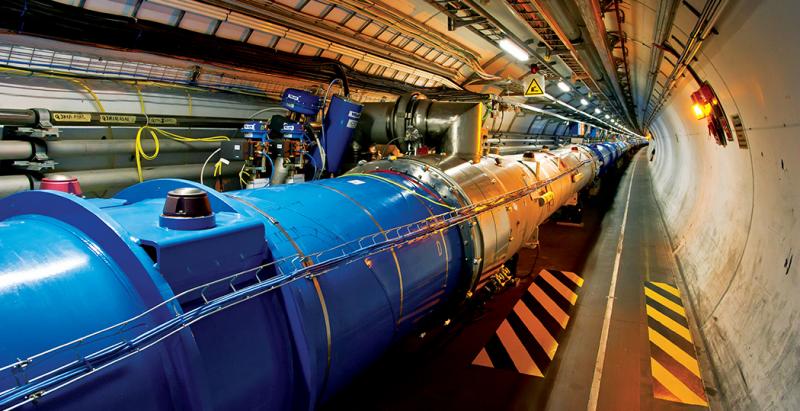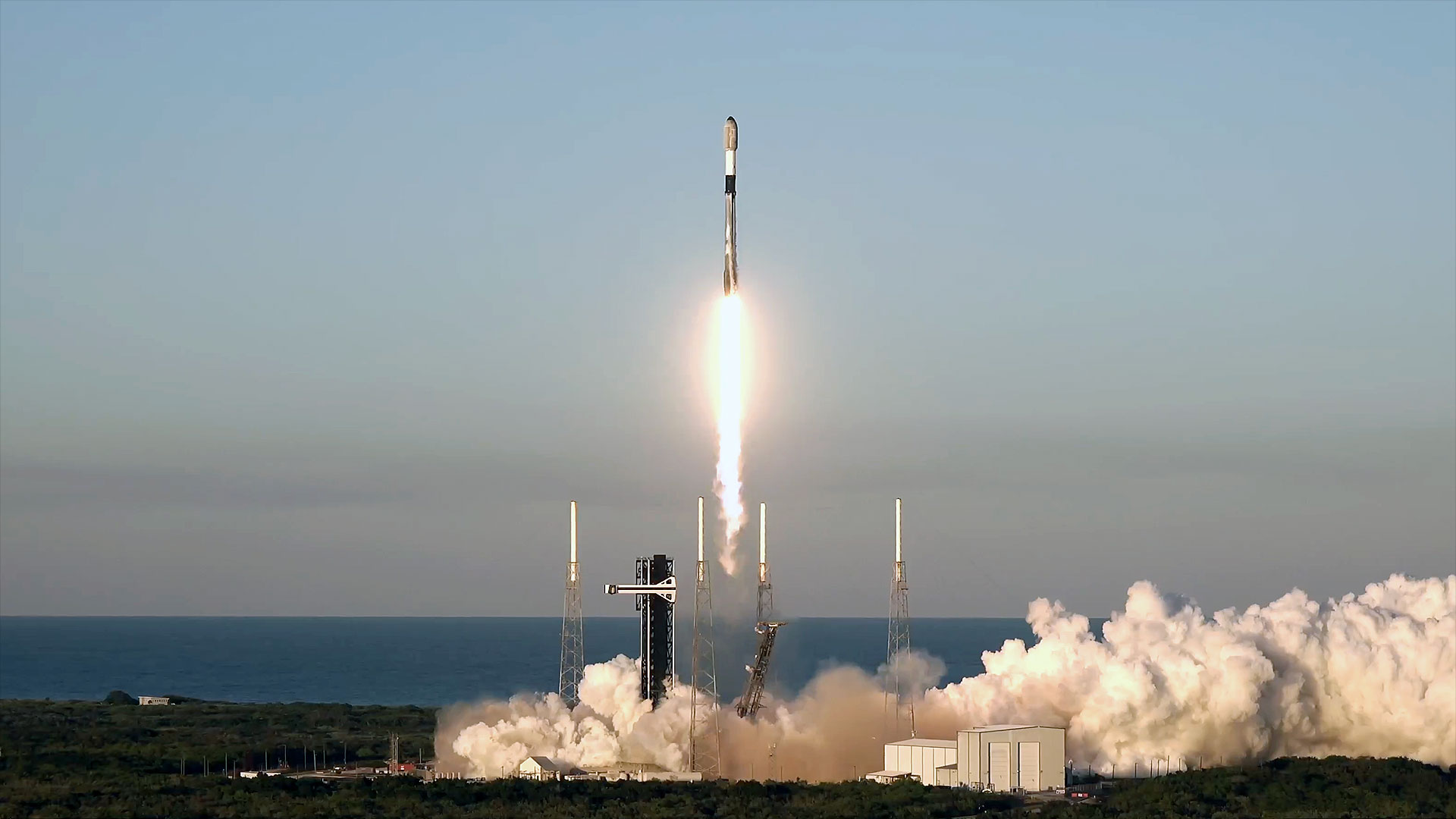Happy Birthday, LHC: Here's to 10 Years of Atom Smashing at the Large Hadron Collider

Ten years ago, the world's largest scientific instrument was turned on and the start of a research dynasty began.
On Sept. 10, 2008, a beam of protons was shot for the first time around the entire 16.5-mile-long (27 kilometers) ring of the Large Hadron Collider (LHC) — the world's largest and highest energy atom smasher ever constructed. Located at the CERN laboratory, just outside Geneva, Switzerland, the LHC was constructed to smash highly energetic beams of protons together at near the speed of light. The stated goal was to create and discover the Higgs boson, the last missing piece of the Standard Model, our best theory for the behavior of subatomic matter. But the goal was bigger than that. Really what we wanted to do was to discover something completely unexpected — so big and so new that it would mean we'd have to rewrite the textbooks.
And the LHC didn't turn on quietly. In the weeks and months prior, the press was jam-packed with breathless stories of fears that the LHC would make a black hole that would destroy the Earth. The media did a good job dispelling the lurid claims, but the story was simply too good to not print, even among the most responsible print, online and broadcast outlets.
The CERN laboratory where the LHC is housed decided to invite the press to see the inaugural beam of the LHC. The black hole frenzy ensured that the media showed up in a big way. BBC, CNN, Reuters and many dozen international media outlets were there for the festivities. Black holes aside, it was a dangerous choice from a PR point of view: Brand-new accelerators are finicky beasts, and the LHC was especially so. It consists of thousands of magnets and tens of thousands of power supplies, monitoring electronics, and more. The slightest mishap could have delayed, for days or weeks, the first successful circulation of beam. [Photos: The World's Largest Atom Smasher (LHC)
There were some tense moments that morning. The first few attempts failed due to some rebellious power supplies. However, just shy of 10:30 a.m. local time, the accelerator operators successfully threaded a very low intensity beam of protons through the entire complex. Because the LHC is essentially two accelerators — to accommodate beams going in opposite directions — the next step was to guide a beam through the second set of beam pipes. That happened shortly after the first success. The world's media announced the technical accomplishment literally as it happened. Particle physics rarely gets that kind of media exposure.
Despite the worldwide excitement, what was accomplished on that day was relatively modest. Low energy, low intensity, beams from feeder accelerators had been injected into the LHC. The beams had cycled around the ring a couple of times, at low energy, meaning the lowest energy the LHC was designed for. The way the LHC works is it accepts a particle beam from smaller accelerators and then accelerates the beam to an energy over 15 times higher than it receives. On this first attempt, there was never any intent to accelerate the beam. Just getting it around the ring successfully was enough.
In addition, the intensity of the beams was less than a ten-millionth of the design intensity. In particle beams, intensity is similar to brightness when one talks about light. The beams can be made more intense by adding more protons or focusing the beam to a smaller size. On that day, focusing was still a future goal and only a very few protons were put in the accelerator. And initially, the timing of the actual accelerator electronics wasn't quite right. So, there was clearly a way to go.
Breaking space news, the latest updates on rocket launches, skywatching events and more!
But, no matter. It was exciting, and it was certainly an important stepping stone on the way to full operations. Corks were popped. Champagne was drunk. Backs were slapped and pictures were taken. It was a good day.
I wasn't at CERN for first beam. After all, my interest in the LHC program is to use it to smash high-energy particles, and everybody knew that no collisions would occur then. Instead, I was at Fermilab, America's flagship particle accelerator laboratory and the most impactful research institution to work on LHC data analysis, besides CERN itself. The two laboratories have a sibling relationship, and we cheer for each other when a technical hurdle is overcome. At Fermilab, we decided to host a pajama party for the scientists and local community on the night of Sept. 10. It was extraordinary. Hundreds of local people showed up at 2:00 a.m. and waited for the successful circulation of beam at 4:30 a.m. local time. I walked around, talking to members of the public, reporters who couldn't convince their editors to send them to Europe and other scientists. The cheers from the crowd were loud enough that I like to think they could hear them at CERN, 4,400 miles to the east.
Of course, the successes of the morning of Sept. 10, 2008, were very important, but they were just a step toward the desired outcome, which was to commission the most powerful particle accelerator on the planet. To do that, the 1,232 giant magnets surrounding the LHC needed to be put through their paces and tested at full electrical current. So, the CERN accelerator staff turned their attention to finishing that. And that's where things went awry.
On Sept. 22, the operators were shaking down the last set of magnets, when a faulty solder joint caused a copper busbar to overheat, causing it to melt, then arc, and then puncture the thermos bottle that held the liquid helium that allowed the magnets to withstand the ten thousand amperes of current that made the powerful magnetic fields possible. [Gallery: Search for the Higgs Boson at the LHC]
With that puncture, the helium was released at high pressure…forming a jet sufficiently strong to push a 35-ton magnet sideways by 18 inches and pull mounting brackets out of solid concrete. The helium was at minus 450 Fahrenheit and it cooled down the LHC tunnel for a mile surrounding the damage. Repairing the damage and adding additional fault protection equipment took over a year.
It was on Feb. 27, 2010, that the LHC accelerator staff were ready to try again. And, over the course of about an hour and a quarter, they repeated the exercise, again circulating beams in opposite directions. This time, the effort was attempted without first notifying the media. And it was on March 19 that the staff finally accelerated the beam to an energy 3.5 times higher than the previous world record accelerator, the Fermilab Tevatron.
I happened to be at CERN that day, and the achievement was accomplished in the wee hours just before dawn. I watched the monitors with colleagues and, when stable beam was declared, the champagne, back slapping and cheers happened again, this time without television cameras.
Since that day, the LHC has been simply a scientific phenom…delivering extraordinary beams to four detectors arrayed around the ring. The scientific output to date has been prodigious, with the two bigger experiments each publishing over 800 papers, and the entire research program publishing over 2,000.
The most impactful discovery in the past decade was the Higgs boson, the last missing piece of the Standard Model of particle physics. It was announced on July 4, 2012, again to a worldwide audience, with coverage on over a thousand television stations to a billion viewers. Again, the world shared the excitement of discovery. [6 Implications of Finding a Higgs Boson Particle]
And the future of the LHC is bright indeed. While we've successfully operated the facility for a decade now, the intent is to continue using the accelerator to make discoveries. Currently, the plan is to continue operations for at least the next two decades. In fact, at the end of 2018, it is estimated that the experiments at the LHC will have collected only 3 percent of the data that will be recorded over the facility's lifetime. At the end of 2018, the LHC will pause operations for two years for refurbishment and upgrades. In the spring of 2021, it will resume operations with much improved detectors.
It's not possible to know what scientific truths we'll uncover using the LHC. That's the thing about doing science…if we knew what we we'd discover, it wouldn't be called research. But the LHC is, without a doubt, an intellectual and technological jewel – an achievement of which researchers of yesteryear could only dream. The LHC can probe the smallest distance scales, the highest energies, and recreate conditions last common in the universe just a scant tenth of a trillionth of a second after the Big Bang. It's an instrument of exploration and discovery. And we're just getting started. It's going to be glorious.
Happy Birthday, LHC.
Originally published on Live Science.
Don Lincoln is a physics researcher at Fermilab. He is the author of "The Large Hadron Collider: The Extraordinary Story of the Higgs Boson and Other Stuff That Will Blow Your Mind" (Johns Hopkins University Press, 2014), and he produces a series of science education videos. Follow him on Facebook. The opinions expressed in this commentary are his.
Don Lincoln contributed this article to Live Science's Expert Voices: Op-Ed & Insights.


